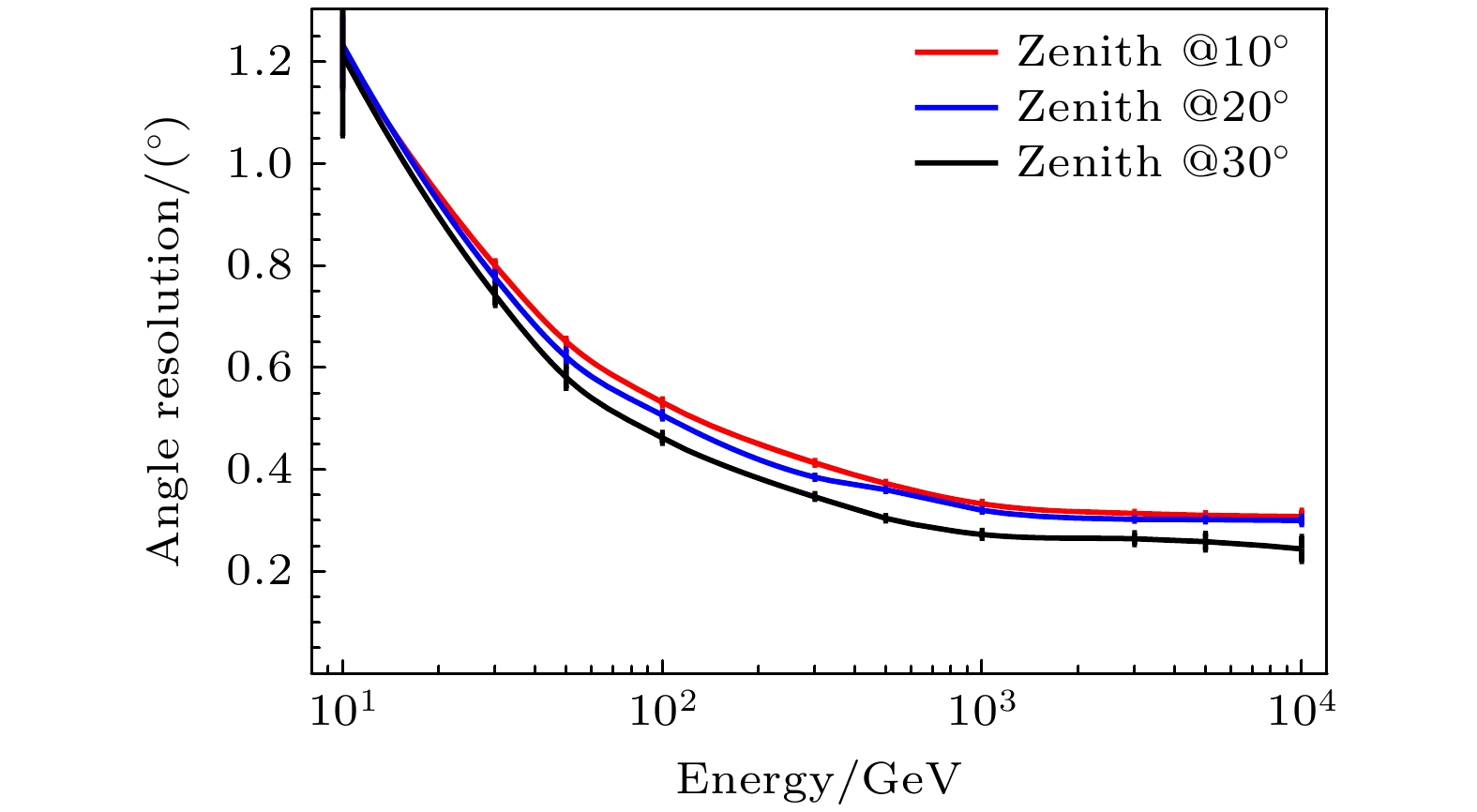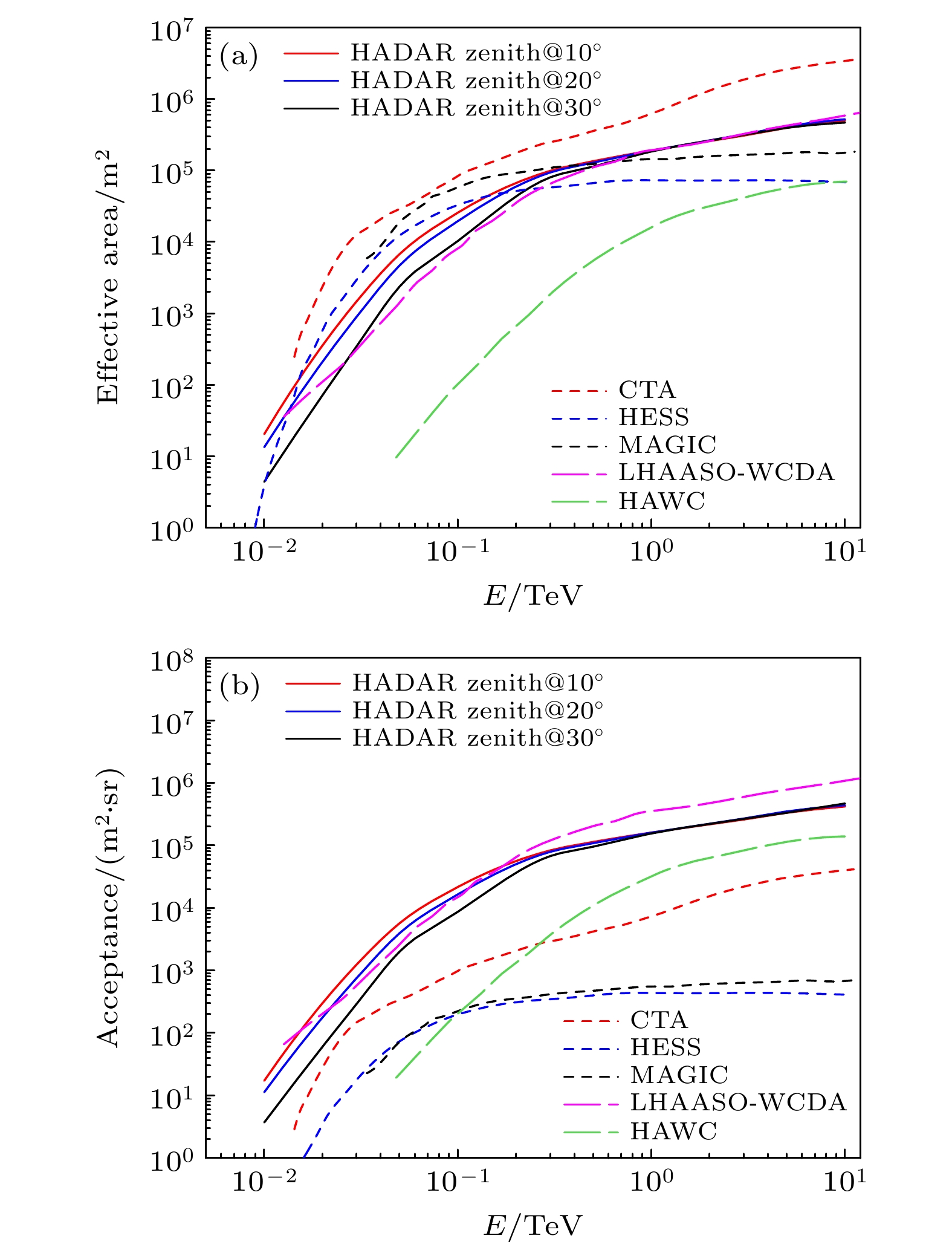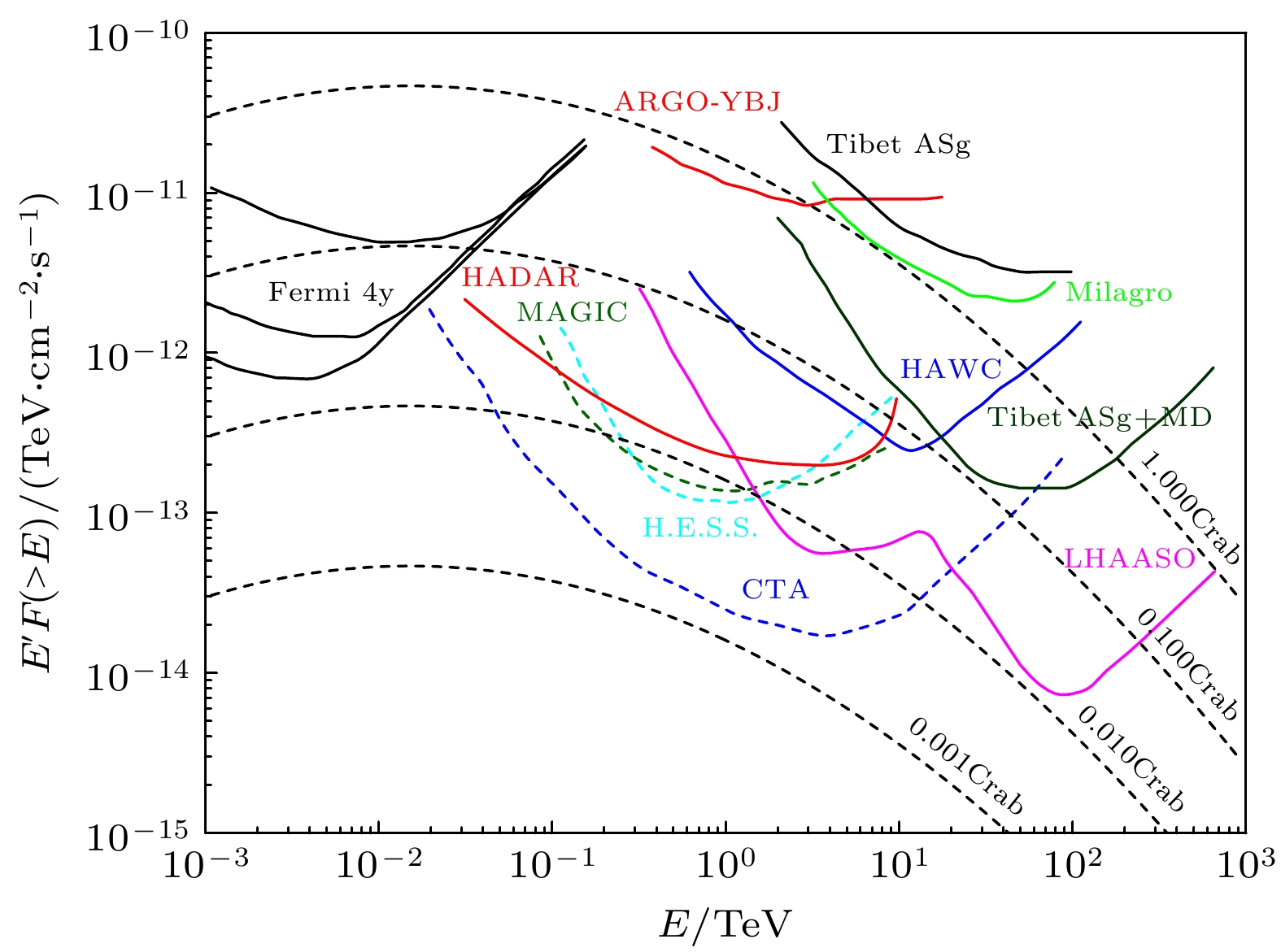-
The High Altitude Detection of Astronomical Radiation (HADAR) experiment is a refracting terrestrial telescope array based on the atmospheric Cherenkov imaging technique. It is a hybrid array consisting of four water-lens telescopes and a surrounding scintillation detector array for observing Cherenkov light induced by 10 GeV–10 TeV cosmic rays and gamma rays in the atmosphere. The water-lens telescope mainly consists of a hemispherical lens with a diameter of 5 m acting as a Cherenkov light collector, a cylindrical metal tank with a 4 m radius and 7 m height, and an imaging system at the bottom of the tank. The sky region covered by HADAR is much larger than the current generation of Imaging Atmospheric Cherenkov Telescopes, and even the CTA. The field-of-view (FOV) of HADAR can reach up to 60 degrees. The HADAR experiment possesses the advantages of a large field-of-view and low energy threshold, so it can continuously scan wide portions of the sky and easily observe extragalactic gamma-ray sources. The majority of the extragalactic gamma-ray sources detected at very high energy (VHE) energies are active galactic nuclei (AGNs). In this study, we present the potential of using the HADAR experiment for detecting AGN. Based on the AGN catalog sources of the Fermi Large Area Telescope (Fermi-LAT), the observed energy is extrapolated to the VHE range. The VHE gamma rays propagating over cosmological distances can interact with the low-energy of the extragalactic background light (EBL) and produce electron-positron pairs. Therefore, we consider the absorption effects of different EBL models when calculating the expected gamma ray spectra of the AGN sample. We select the sample with redshift measurements and locations inside the FOV of HADAR from 4LAC catalog. In total, there are 375 BL Lacertae objects (BL Lacs) and 289 flat-spectrum radio quasars (FSRQs) satisfying the selection conditions. The integral gamma ray spectra are derived and compared with the sensitivity curve of HADAR, the number of sources with fluxes above the sensitivity of HADAR is counted. Further, we calculate the statistical significance of HADAR for AGN source observation based on the equi-zenith angle sky scanning analysis method. The simulation results reveal that a total of 31 sources of Fermi-LAT AGN can be detected by HADAR with a significance greater than five standard deviations over a one-year survey period, most of which are BL Lacs.
-
Keywords:
- HADAR /
- atmospheric Cherenkov telescope /
- active galactic nuclei /
- significance
[1] Aharonian F, Akhperjanian A G, Bazer-Bachi A R 2007 Astrophys. J. 664 L71
 Google Scholar
Google Scholar
[2] Albert J, Aliu E, Anderhub H 2007 Astrophys. J. 669 862
 Google Scholar
Google Scholar
[3] Sikora M, Begelman M C, Rees M J 1994 Astrophys. J. 421 153
 Google Scholar
Google Scholar
[4] Marscher A P 2016 Galaxies. 4 37
 Google Scholar
Google Scholar
[5] Aharonian F 2000 New. Astron. 5 377
 Google Scholar
Google Scholar
[6] Mücke A, Protheroe R J, Engel R, Rachen J P, Stanev T 2003 Astropart. Phys. 18 593
 Google Scholar
Google Scholar
[7] Fossati G, Maraschi L, Celotti A, Comastri A, Ghisellini G 1998 Mon. Not. R. Astron. Soc. 299 433
 Google Scholar
Google Scholar
[8] Ghisellini G, Righi C, Costamante L, Tavecchio F 2017 Mon. Not. R. Astron. Soc. 469 255
 Google Scholar
Google Scholar
[9] Padovani P, Giommi P 1995 Mon. Not. R. Astron. Soc. 277 1477
 Google Scholar
Google Scholar
[10] Ajello M, Arimoto M, Axelsson M 2019 Astrophys. J. 878 52
 Google Scholar
Google Scholar
[11] Hinton J A 2004 New. Astron. Rev. 48 331
 Google Scholar
Google Scholar
[12] Aleksić J, Ansoldi S, Antonelli L A 2016 Astropart. Phys. 72 61
 Google Scholar
Google Scholar
[13] Weekes T C, Badran H, Biller S D 2002 Astropart. Phys. 17 221
 Google Scholar
Google Scholar
[14] Abeysekara A U, Alfaro R, Alvarez C 2013 Astropart. Phys. 50 26
 Google Scholar
Google Scholar
[15] Sciascio G D 2016 Nucl. Part. Phys. P. 279 166
 Google Scholar
Google Scholar
[16] CTA Consortium 2018 Science with the Cherenkov Telescope Array (Singapore: World Scientific) pp11–26
[17] Punch M, Akerlof C W, Cawley M F 1992 Nature 358 477
 Google Scholar
Google Scholar
[18] Quinn J, Akerlof C W, Biller S 1996 Astrophys. J. 456 L83
 Google Scholar
Google Scholar
[19] Albert J, Aliu E, Anderhub H 2008 Science 320 1752
 Google Scholar
Google Scholar
[20] Aliu E, Archambault S, Arlen T 2012 Astrophys. J. 750 94
 Google Scholar
Google Scholar
[21] Abramowski A, Acero F, Aharonian F 2012 Astron. Astrophys. 538 A103
 Google Scholar
Google Scholar
[22] Abramowski A, Acero F, Aharonian F 2013 Mon. Not. R. Astron. Soc. 434 1889
 Google Scholar
Google Scholar
[23] Abdo A A, Ackermann M, Ajello M 2011 Astrophys. J. 736 131
 Google Scholar
Google Scholar
[24] Ahnen M L, Ansoldi S, Antonelli L A 2017 Astron. Astrophys. 603 A31
 Google Scholar
Google Scholar
[25] Abdalla H, Adam R, Aharonian F 2021 Astron. Astrophys. 648 A23
 Google Scholar
Google Scholar
[26] Arlen T, Aune T, Beilicke M 2012 Astrophys. J. 762 92
 Google Scholar
Google Scholar
[27] Abdo A A, Ackermann M, Ajello M 2011 Astrophys. J. 727 129
 Google Scholar
Google Scholar
[28] Bartoli B, Bernardini P, Bi X J 2012 Astrophys. J. 758 2
 Google Scholar
Google Scholar
[29] Albert J, Aliu E, Anderhub H 2007 Astrophys. J. 667 358
 Google Scholar
Google Scholar
[30] Gilmore R C, Madau P, Primack J R, Somerville R S, Haardt F 2009 Mon. Not. R. Astron. Soc. 399 1694
 Google Scholar
Google Scholar
[31] Inoue S, Salvaterra R, Choudhury T R, Ferrara A, Ciardi B, Schneider R 2010 Mon. Not. R. Astron. Soc. 404 1938
 Google Scholar
Google Scholar
[32] Takahashi K, Inoue S, Ichiki K, Nakamura T 2011 Mon. Not. R. Astron. Soc. 410 2741
 Google Scholar
Google Scholar
[33] Wang Z, Guo Y Q, Cai H 2018 Exp. Astron. 45 363
 Google Scholar
Google Scholar
[34] Xin G G, Yao Y H, Qian X L 2021 Astrophys. J. 923 112
 Google Scholar
Google Scholar
[35] Holler M, Balzer A, Chalmé-Calvet R, de Naurois M, and Zaborov D 2015 Proceedings of the 34th International Cosmic Ray Conference, Hague, Netherlands, 30 July–6 August 2015 34 980
[36] Aleksić J, Ansoldi S, Antonelli L A 2016 Astropart. Phys. 72 76
 Google Scholar
Google Scholar
[37] Ma X H, Bi Y J, Cao Z 2022 Chinese Phys. C 46 030001
 Google Scholar
Google Scholar
[38] DeYoung T 2012 Nucl. Instrum. Meth. A 692 72
 Google Scholar
Google Scholar
[39] Zhao Y, Yuan Q, Bi X J, Zhu F R, Jia H Y 2016 Int. J. Mod. Phys. D 25 1650006
 Google Scholar
Google Scholar
[40] Cai H, Zhang Y, Liu C 2017 J. Instrum. 12 09023
 Google Scholar
Google Scholar
[41] Chen T L, Liu C, Gao Q 2019 Nucl. Instrum. Meth. A 927 46
 Google Scholar
Google Scholar
[42] Ajello M, Angioni R, Axelsson M 2020 Astrophys. J. 892 105
 Google Scholar
Google Scholar
[43] Stecker F W, De Jager O C, Salamon M H 1992 Astrophys. J. 390 L49
 Google Scholar
Google Scholar
[44] Franceschini A, Rodighiero G, Vaccari M 2008 Astron. Astrophys. 487 837
 Google Scholar
Google Scholar
[45] Finke J D, Razzaque S, Dermer C D 2010 Astrophys. J. 712 238
 Google Scholar
Google Scholar
[46] Domínguez A, Primack J R, Rosario D J 2011 Mon. Not. R. Astron. Soc. 410 2556
 Google Scholar
Google Scholar
[47] Gilmore R C, Somerville R S, Primack J R, Domínguez A 2012 Mon. Not. R. Astron. Soc. 422 3189
 Google Scholar
Google Scholar
[48] Helgason K, Kashlinsky A 2012 Astrophys. J. Lett. 758 L13
 Google Scholar
Google Scholar
[49] Inoue Y, Inoue S, Kobayashi M A R, Makiya R, Niino Y, Totani T 2013 Astrophys. J. 768 197
 Google Scholar
Google Scholar
[50] Stecker F W, Scully S T, Malkan M A 2016 Astrophys. J. 827 6
 Google Scholar
Google Scholar
[51] Abdollahi S, Acero F, Ackermann M 2020 Astrophys. J. Suppl. S. 247 33
 Google Scholar
Google Scholar
[52] Amenomori M, Ayabe S, Chen D 2005 Astrophys. J. 633 1005
 Google Scholar
Google Scholar
[53] Gaisser T K, Stanev T, Tilav S 2013 Front. Phys. 8 748
 Google Scholar
Google Scholar
-
图 6 预期的经过5种不同EBL模型吸收之后的AGN源的伽马射线能谱图及与HADAR灵敏度曲线的比较. 其中蓝色实线为BL Lacs, 红色虚线为FSRQs, 黑色粗线为HADAR的灵敏度曲线
Figure 6. Expected γ-ray spectra of the AGN sample after EBL absorption. Different panels are for the five different EBL models as labeled. The blue solid lines represent BL Lacs and red dashed lines represent FSRQs. The sensitivity of HADAR is shown with the thick black line
表 1 HADAR实验一年观测时间对河外源观测的显著性估计, 列表从左到右依次为: Fermi源名称, 相关联的源, 赤经, 赤纬, 红移, 归一化的流强,
$ E_0 $ , 谱指数α, 谱指数β, 一年内的有效观测时间, 预期显著性Table 1. Expected significance of extragalactic sources with HADAR between 30 GeV and 10 TeV using a 1 yr observation time. Columns from left to right are as follows: Fermi source name, associations, R.A., Dec., redshift, normalization flux,
$ E_0 $ , spectral index α, spectral index β, effective livetime, expected significance by HADARFermi Source Assoc. R.A./(°) Dec./(°) z $N_0/(\rm TeV^{-1}{\cdot}cm^{-2}{\cdot}s^{-1})$ $ E_0 $/GeV α β Livetime/hrs S/σ 4FGL J0112.1+2245 S2 0109+22 18.03 22.75 0.265 1.399× 10–5 0.76 1.99 0.057 277.8 8.9 4FGL J0222.6+4302 3C66A 35.67 43.04 0.444 1.008×10–5 1.21 1.88 0.045 264.2 21.5 4FGL J0319.8+1845 1E 0317.0+1835 49.97 18.75 0.190 1.618×10–8 5.98 1.67 0.0 257.8 5.1 4FGL J0650.7+2503 1ES 0647+250 102.70 25.05 0.203 6.587×10–7 2.06 1.66 0.035 286.0 25.3 4FGL J0738.1+1742 PKS 0735+17 114.54 17.71 0.424 2.640×10–6 1.54 1.97 0.065 251.3 7.4 4FGL J0809.8+5218 1ES 0806+524 122.46 52.31 0.138 2.222×10–6 1.30 1.80 0.041 193.9 15.1 4FGL J0915.9+2933 Ton 0396 138.99 29.55 0.190 1.068×10–6 1.35 1.74 0.083 294.7 7.8 4FGL J1015.0+4926 1H 1013+498 153.77 49.43 0.212 7.019×10–6 1.01 1.76 0.041 220.0 29.9 4FGL J1058.6+5627 TXS 1055+567 164.67 56.46 0.143 2.525×10–6 1.06 1.87 0.040 149.4 6.3 4FGL J1104.4+3812 Mkn 421 166.12 38.21 0.030 1.842×10–5 1.29 1.72 0.023 284.9 529.6 4FGL J1117.0+2013 RBS 0958 169.27 20.23 0.139 4.167×10–7 1.84 1.95 0.0 266.1 5.7 4FGL J1150.6+4154 RBS 1040 177.66 41.91 0.320 5.965×10–7 1.73 1.65 0.091 270.0 6.6 4FGL J1217.9+3007 B2 1215+30 184.48 30.12 0.130 7.113×10–6 1.07 1.88 0.040 295.1 31.6 4FGL J1221.3+3010 PG 1218+304 185.34 30.17 0.184 1.742×10–7 4.44 1.71 0.0 295.2 31.3 4FGL J1221.5+2814 W Comae 185.38 28.24 0.102 3.516×10–6 1.06 2.16 0.0 293.1 6.6 4FGL J1224.4+2436 MS 1221.8+2452 186.12 24.61 0.219 2.417×10–7 2.36 1.89 0.0 284.6 5.5 4FGL J1224.9+2122 4C +21.35 186.23 21.38 0.434 2.187×10–4 0.39 2.27 0.045 271.8 5.4 4FGL J1230.2+2517 ON 246 187.56 25.30 0.135 6.100×10–6 0.82 1.99 0.061 286.7 6.0 4FGL J1231.7+2847 B2 1229+29 187.93 28.79 0.236 7.991×10–7 1.58 1.99 0.0 293.9 5.1 4FGL J1427.0+2348 PKS 1424+240 216.76 23.80 0.604 6.508×10–6 1.23 1.70 0.060 281.8 23.8 4FGL J1428.5+4240 H 1426+428 217.13 42.68 0.129 2.772×10–8 5.02 1.66 0.0 266.1 9.7 4FGL J1555.7+1111 PG 1553+113 238.93 11.19 0.360 3.325×10–6 1.85 1.54 0.070 199.5 58.9 4FGL J1653.8+3945 Mkn 501 253.47 39.76 0.033 4.439×10–6 1.48 1.71 0.018 279.5 258.4 4FGL J1725.0+1152 1H 1720+117 261.27 11.87 0.180 7.214×10–7 2.22 1.76 0.056 205.9 13.9 4FGL J1728.3+5013 I Zw 187 262.08 50.23 0.055 1.950×10–7 3.01 1.78 0.0 213.2 24.1 4FGL J1838.8+4802 GB6J1838+4802 279.71 48.04 0.300 3.198×10–7 2.55 1.85 0.0 231.3 6.1 4FGL J2116.2+3339 B2 2114+33 319.06 33.66 0.350 1.068×10–6 1.71 1.74 0.102 294.4 7.2 4FGL J2202.7+4216 BL Lac 330.69 42.28 0.069 4.498×10–5 0.75 2.18 0.060 268.2 15.0 4FGL J2250.0+3825 B3 2247+381 342.51 38.42 0.119 2.881×10–8 5.33 1.72 0.060 284.2 9.9 4FGL J2253.9+1609 3C 454.3 343.50 16.15 0.859 6.408×10–4 0.52 2.39 0.0 240.7 14.7 4FGL J2323.8+4210 1ES 2321+419 350.97 42.18 0.059 2.926×10–7 2.47 1.90 0.0 268.7 13.4 -
[1] Aharonian F, Akhperjanian A G, Bazer-Bachi A R 2007 Astrophys. J. 664 L71
 Google Scholar
Google Scholar
[2] Albert J, Aliu E, Anderhub H 2007 Astrophys. J. 669 862
 Google Scholar
Google Scholar
[3] Sikora M, Begelman M C, Rees M J 1994 Astrophys. J. 421 153
 Google Scholar
Google Scholar
[4] Marscher A P 2016 Galaxies. 4 37
 Google Scholar
Google Scholar
[5] Aharonian F 2000 New. Astron. 5 377
 Google Scholar
Google Scholar
[6] Mücke A, Protheroe R J, Engel R, Rachen J P, Stanev T 2003 Astropart. Phys. 18 593
 Google Scholar
Google Scholar
[7] Fossati G, Maraschi L, Celotti A, Comastri A, Ghisellini G 1998 Mon. Not. R. Astron. Soc. 299 433
 Google Scholar
Google Scholar
[8] Ghisellini G, Righi C, Costamante L, Tavecchio F 2017 Mon. Not. R. Astron. Soc. 469 255
 Google Scholar
Google Scholar
[9] Padovani P, Giommi P 1995 Mon. Not. R. Astron. Soc. 277 1477
 Google Scholar
Google Scholar
[10] Ajello M, Arimoto M, Axelsson M 2019 Astrophys. J. 878 52
 Google Scholar
Google Scholar
[11] Hinton J A 2004 New. Astron. Rev. 48 331
 Google Scholar
Google Scholar
[12] Aleksić J, Ansoldi S, Antonelli L A 2016 Astropart. Phys. 72 61
 Google Scholar
Google Scholar
[13] Weekes T C, Badran H, Biller S D 2002 Astropart. Phys. 17 221
 Google Scholar
Google Scholar
[14] Abeysekara A U, Alfaro R, Alvarez C 2013 Astropart. Phys. 50 26
 Google Scholar
Google Scholar
[15] Sciascio G D 2016 Nucl. Part. Phys. P. 279 166
 Google Scholar
Google Scholar
[16] CTA Consortium 2018 Science with the Cherenkov Telescope Array (Singapore: World Scientific) pp11–26
[17] Punch M, Akerlof C W, Cawley M F 1992 Nature 358 477
 Google Scholar
Google Scholar
[18] Quinn J, Akerlof C W, Biller S 1996 Astrophys. J. 456 L83
 Google Scholar
Google Scholar
[19] Albert J, Aliu E, Anderhub H 2008 Science 320 1752
 Google Scholar
Google Scholar
[20] Aliu E, Archambault S, Arlen T 2012 Astrophys. J. 750 94
 Google Scholar
Google Scholar
[21] Abramowski A, Acero F, Aharonian F 2012 Astron. Astrophys. 538 A103
 Google Scholar
Google Scholar
[22] Abramowski A, Acero F, Aharonian F 2013 Mon. Not. R. Astron. Soc. 434 1889
 Google Scholar
Google Scholar
[23] Abdo A A, Ackermann M, Ajello M 2011 Astrophys. J. 736 131
 Google Scholar
Google Scholar
[24] Ahnen M L, Ansoldi S, Antonelli L A 2017 Astron. Astrophys. 603 A31
 Google Scholar
Google Scholar
[25] Abdalla H, Adam R, Aharonian F 2021 Astron. Astrophys. 648 A23
 Google Scholar
Google Scholar
[26] Arlen T, Aune T, Beilicke M 2012 Astrophys. J. 762 92
 Google Scholar
Google Scholar
[27] Abdo A A, Ackermann M, Ajello M 2011 Astrophys. J. 727 129
 Google Scholar
Google Scholar
[28] Bartoli B, Bernardini P, Bi X J 2012 Astrophys. J. 758 2
 Google Scholar
Google Scholar
[29] Albert J, Aliu E, Anderhub H 2007 Astrophys. J. 667 358
 Google Scholar
Google Scholar
[30] Gilmore R C, Madau P, Primack J R, Somerville R S, Haardt F 2009 Mon. Not. R. Astron. Soc. 399 1694
 Google Scholar
Google Scholar
[31] Inoue S, Salvaterra R, Choudhury T R, Ferrara A, Ciardi B, Schneider R 2010 Mon. Not. R. Astron. Soc. 404 1938
 Google Scholar
Google Scholar
[32] Takahashi K, Inoue S, Ichiki K, Nakamura T 2011 Mon. Not. R. Astron. Soc. 410 2741
 Google Scholar
Google Scholar
[33] Wang Z, Guo Y Q, Cai H 2018 Exp. Astron. 45 363
 Google Scholar
Google Scholar
[34] Xin G G, Yao Y H, Qian X L 2021 Astrophys. J. 923 112
 Google Scholar
Google Scholar
[35] Holler M, Balzer A, Chalmé-Calvet R, de Naurois M, and Zaborov D 2015 Proceedings of the 34th International Cosmic Ray Conference, Hague, Netherlands, 30 July–6 August 2015 34 980
[36] Aleksić J, Ansoldi S, Antonelli L A 2016 Astropart. Phys. 72 76
 Google Scholar
Google Scholar
[37] Ma X H, Bi Y J, Cao Z 2022 Chinese Phys. C 46 030001
 Google Scholar
Google Scholar
[38] DeYoung T 2012 Nucl. Instrum. Meth. A 692 72
 Google Scholar
Google Scholar
[39] Zhao Y, Yuan Q, Bi X J, Zhu F R, Jia H Y 2016 Int. J. Mod. Phys. D 25 1650006
 Google Scholar
Google Scholar
[40] Cai H, Zhang Y, Liu C 2017 J. Instrum. 12 09023
 Google Scholar
Google Scholar
[41] Chen T L, Liu C, Gao Q 2019 Nucl. Instrum. Meth. A 927 46
 Google Scholar
Google Scholar
[42] Ajello M, Angioni R, Axelsson M 2020 Astrophys. J. 892 105
 Google Scholar
Google Scholar
[43] Stecker F W, De Jager O C, Salamon M H 1992 Astrophys. J. 390 L49
 Google Scholar
Google Scholar
[44] Franceschini A, Rodighiero G, Vaccari M 2008 Astron. Astrophys. 487 837
 Google Scholar
Google Scholar
[45] Finke J D, Razzaque S, Dermer C D 2010 Astrophys. J. 712 238
 Google Scholar
Google Scholar
[46] Domínguez A, Primack J R, Rosario D J 2011 Mon. Not. R. Astron. Soc. 410 2556
 Google Scholar
Google Scholar
[47] Gilmore R C, Somerville R S, Primack J R, Domínguez A 2012 Mon. Not. R. Astron. Soc. 422 3189
 Google Scholar
Google Scholar
[48] Helgason K, Kashlinsky A 2012 Astrophys. J. Lett. 758 L13
 Google Scholar
Google Scholar
[49] Inoue Y, Inoue S, Kobayashi M A R, Makiya R, Niino Y, Totani T 2013 Astrophys. J. 768 197
 Google Scholar
Google Scholar
[50] Stecker F W, Scully S T, Malkan M A 2016 Astrophys. J. 827 6
 Google Scholar
Google Scholar
[51] Abdollahi S, Acero F, Ackermann M 2020 Astrophys. J. Suppl. S. 247 33
 Google Scholar
Google Scholar
[52] Amenomori M, Ayabe S, Chen D 2005 Astrophys. J. 633 1005
 Google Scholar
Google Scholar
[53] Gaisser T K, Stanev T, Tilav S 2013 Front. Phys. 8 748
 Google Scholar
Google Scholar
Catalog
Metrics
- Abstract views: 10163
- PDF Downloads: 182
- Cited By: 0















 DownLoad:
DownLoad:








